|
Rise and Fall
of Passenger Rail in
the Calgary-Edmonton Corridor Revised May
2022
Photo descriptions
and credits at bottom of page.
Regularly scheduled passenger trains served the area between Calgary
and Edmonton on the Canadian Pacific line from 1891 to 1985.

When the transcontinental Canadian Pacific Railway reached Fort Calgary
in 1883, the Calgary-Edmonton Trail gained significance as a major
transportation corridor. At the time there were very few settlers
between Fort Calgary and Fort Edmonton. But with the arrival of the
railway in Calgary, a small community started to develop at the Red Deer
River Crossing
and a crude stagecoach service began carrying mail, goods and passengers
north and south along the trail. The trip between the two forts took 4 to 5 days requiring
several stopping houses along the way. The one way fare between
Calgary and Edmonton was $25 (at the time, a good wage was $2 per day).

Almost
immediately, there developed a demand for rail service.
The Calgary & Edmonton Railway received its first charter in 1885
but nothing happened. A new charter was awarded in 1890 with the Red
Deer River crossing determined in July of that year as a result of
an agreement with Rev. Leonard Gaetz downstream from the Crossing
settlement. The new railway was built from Calgary to the new
townsite of Red Deer by the fall of 1890, a major feat in just 4
months. The first passenger train ran from south of Penhold to
Calgary that fall prior to four bridges being built across the
meandering Waskasoo Creek.
The bridge over the river was constructed
during the winter and the line was completed from Red Deer to Strathcona by July 1891.

The
CPR leased the line and took over operations in August 1891 with regular passenger service
beginning in 1892. The travel time was 12 hours with a one-way fare
of $10 between Calgary and Edmonton, marking the end of stagecoach
service. However, there was no direct CPR link over the North
Saskatchewan River from Strathcona to Edmonton.
Two of the builders of the Calgary and Edmonton Railway, William
McKenzie and Donald Mann, started a new railway, the Canadian
Northern, which reached Edmonton from Manitoba in 1902. To prevent
takeover of the C&E Railway by the Canadian Northern,
Canadian Pacific signed a 999 year lease with the C&E and later
purchased the line as a subsidiary of the parent CPR.
The Canadian
Northern subsequently planned to build a new direct Calgary-Edmonton line
through Red Deer but plans were abandoned before the First World
War.
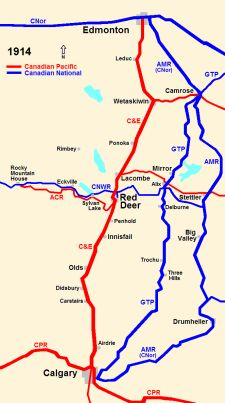 A
branch line from Lacombe to Alix opened in 1905 and it was extended to Stettler
in 1906
with immediate regular passenger service between several communities
along the line to Red Deer. A
branch line from Lacombe to Alix opened in 1905 and it was extended to Stettler
in 1906
with immediate regular passenger service between several communities
along the line to Red Deer.
Also in 1906, a branch line was constructed between Wetaskiwin and Camrose,
also providing connecting passenger service to Red Deer. The line
was extended to Hardisty in 1907 and to Saskatoon in 1910 creating a
direct link with Winnipeg. A new passenger service was created,
called the Great West Express, between Winnipeg and Edmonton giving
Canadian Pacific passengers a choice of transcontinental service
either through Camrose and Saskatoon or south through Calgary.
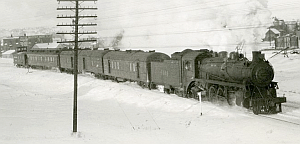
Red Deer became the Canadian Pacific divisional point on the line in 1908
with several improvements to the railway facilities that included a
new bridge across the river and a new
grand station at the head of Ross Street completed in 1910.
Meanwhile, the
CPR Stettler line was extended to Castor in 1910 and Consort in 1914.
The Red Deer-based Alberta Central Railway, envisioned to become a
major Western Canada line linking the west coast with Hudson Bay and Moose Jaw, started construction in 1910.
It was leased to the CPR
in 1911 and taken over by the CPR the following year as a CPR
subsidiary when the company went bankrupt. The CPR finished
construction work on the line reaching Rocky Mountain House in 1914
but Canadian Pacific did not
have the same vision as the ACR. There was regular mixed passenger
service three times a week in each direction between Red Deer and
Rocky Mountain House until 1957. The line did have a major impact on
the settlement and development west of Red Deer.
The
Alberta Midland (a subsidiary of Canadian Northern) built a north-south line from
Edmonton through Camrose, Stettler, Big Valley to Drumheller in
1911 and connected with Calgary in 1914. Big Valley was the
divisional point until the railway was absorbed into the Canadian
National Railways after the First World War.
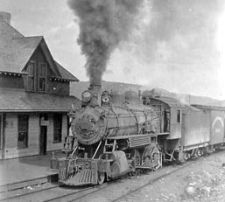
The
Canadian Northern Western Railway (another subsidiary of Canadian
Northern) built a line west from Stettler to Sylvan Lake
in 1911 with a spur to North Red Deer. It reached Rocky Mountain House in 1912
ahead of the Alberta Central and was extended to Nordegg (Brazeau) in 1914.

For many years, people had a choice of two parallel lines of
passenger service, thrice-weekly on mixed trains, between Red Deer and
Rocky Mountain House. Mixed passenger service was offered on CNWR
thrice-weekly to Nordegg (Brazeau).
The Canadian Pacific
High Level Bridge opened in 1913 connecting Strathcona with Edmonton
and a new passenger station was constructed in downtown Edmonton.
Strathcona remained the northern divisional point for the C&E
Railway as well as the Wetaskiwin to Saskatoon line.

The Grand Trunk Pacific built a north-south line through Camrose, Mirror,
Delburne, and Three Hills in 1913 which was extended to Calgary in
1914. Mirror became the divisional point for the line.
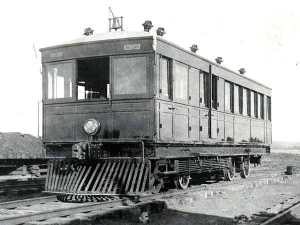 Another line, the Lacombe and Blindman Valley Electric Railway
(which was never electrified and later renamed the Lacombe and
Northwestern Railway), was built by local businessmen and
farmers from Lacombe to Bentley in 1917. It was extended to Rimbey
in 1919 and eventually connected with Leduc in 1931. One of the
earliest self-propelled passenger rail cars made by Baguley was used
for a short time on the line but it had a tendency to derail on
curves. The line was taken over by CPR in 1928. Passenger service
was offered on mixed trains thrice weekly each way until 1960. Another line, the Lacombe and Blindman Valley Electric Railway
(which was never electrified and later renamed the Lacombe and
Northwestern Railway), was built by local businessmen and
farmers from Lacombe to Bentley in 1917. It was extended to Rimbey
in 1919 and eventually connected with Leduc in 1931. One of the
earliest self-propelled passenger rail cars made by Baguley was used
for a short time on the line but it had a tendency to derail on
curves. The line was taken over by CPR in 1928. Passenger service
was offered on mixed trains thrice weekly each way until 1960.
Due to extreme financial pressures from a recession and the war and
perhaps over-building,
Canadian Northern and Grand Trunk Pacific effectively went bankrupt
and become part of the new government-controlled Canadian
National Railways between 1919 and 1923. One of the consequences of
rationalization was that divisional status was removed from Big
Valley. Mirror became the dominant railway town on CN between
Calgary and Edmonton.
 Canadian
National built a bridge across the Red Deer River and a passenger
station on the east side of downtown Red Deer in 1920 providing
passenger service through Mirror to Edmonton or Calgary. With the river bridge being washed out in the spring floods a number of
times, the railway abandoned the river crossing in 1941 but continued
service to the city station grounds via a connection to the Canadian
Pacific along the present site of the museum, downtown Safeway store and
Red Deer Lodge. Canadian
National built a bridge across the Red Deer River and a passenger
station on the east side of downtown Red Deer in 1920 providing
passenger service through Mirror to Edmonton or Calgary. With the river bridge being washed out in the spring floods a number of
times, the railway abandoned the river crossing in 1941 but continued
service to the city station grounds via a connection to the Canadian
Pacific along the present site of the museum, downtown Safeway store and
Red Deer Lodge.
By 1930 Canadian Pacific was running 3 Calgary-Edmonton corridor passenger trains
through Red Deer per day in
each direction, taking 6-7 hours between the two largest cities with integrated Red Deer feeders
from Stettler, Rimbey and Rocky Mountain House lines. Virtually all
rail lines in Central Alberta had passenger service. In fact, for
most communities, the railway was the only way to efficiently get
from place to place. The railway was also the social and
communication hub of almost every established community.
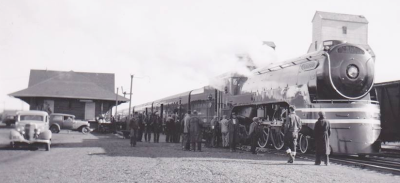 In
1936,
Canadian Pacific introduced "high speed rail" with 'The
Chinook', a specially-designed inter-city light passenger train
between Calgary and Edmonton, reducing travel time to 4-1/2 - 5-1/4 hours at speeds up
to 90-100 mi/hr with up to 22 stops along the line. In
1936,
Canadian Pacific introduced "high speed rail" with 'The
Chinook', a specially-designed inter-city light passenger train
between Calgary and Edmonton, reducing travel time to 4-1/2 - 5-1/4 hours at speeds up
to 90-100 mi/hr with up to 22 stops along the line.
From 1936 to 1955, four passenger trains a day ran the
Calgary-Edmonton route including an overnight train, the 'Eskimo'/'Stampeder',
a 'milk run', and
the 'Chinook' using a 4-4-4 Jubilee F2a class locomotive no. 3001, one of only five of this
class of locomotive ever built. However, during the war years (1940
to 1945), the Jubilee was replaced by much heavier locomotives to
accommodate the large number of military personnel leaving for
service or arriving for training. None of the Jubilee F2a class survived the scrap yard
but two of 20 F1a class of Jubilees (similar but significantly
different)
survived, one in Quebec and one in Pennsylvania. F1a Jubilees were occasionally
seen in Red Deer on their way to Edmonton where they ran the
passenger line to Lloydminster.
Early diesel passenger locomotives were streamlined cab units
referred to as F units, sometimes with the letter 'P' indicating it
had a steam generator for heating passenger cars. The last overnight passenger train ran in
1960.
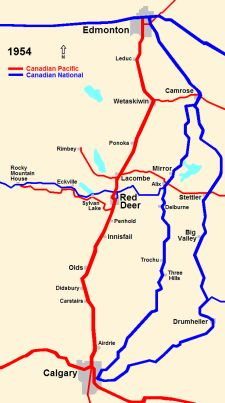 Passenger service and rail infrastructure within all 3 corridors
had remained relatively stable for 40 years (1914-1954) and for
Canadian Pacific, it had been over 60 years. But with increased
competition from airlines, new roadways, the new affordability of
personal vehicles and cheap fuel, the desire for rail passenger
service started to decline. Passenger service and rail infrastructure within all 3 corridors
had remained relatively stable for 40 years (1914-1954) and for
Canadian Pacific, it had been over 60 years. But with increased
competition from airlines, new roadways, the new affordability of
personal vehicles and cheap fuel, the desire for rail passenger
service started to decline.
The
Brazeau Colleries at Nordegg closed in 1955 making CN passenger
trains between Mirror and Rocky Mountain House unprofitable. As a
result, both CN and CP
cancelled all passenger service on the line including Red Deer. The
CP connection in the city proved unsatisfactory so the terminal was
relocated back to the north side of the river in 1960. Several other
marginal rail lines all across Central Alberta and Western Canada
lost passenger service in the late 1950s and early 1960s.
Canadian Pacific cancelled the secondary east-west passenger service (the
Great West Express) between Winnipeg, Saskatoon, Wetaskiwin and
Edmonton in 1960.
Passenger service from Coronation and Stettler to Lacombe and Red
Deer ended in the early 1960s. With the opening of the
Highway 2 expressway in 1961 and 1962, rail passenger service was
further threatened.
 In
an attempt to maintain viable passenger service within the
Calgary-Edmonton corridor, Canadian Pacific replaced 'the Chinook'
Jubilee
with a Budd 'Dayliner' in 1955 cutting the travel time from Calgary
to Edmonton to 3-1/2 hours compared to the approximate five hour run
of 'the Chinook'. Shortly thereafter, Dayliners replaced the other
passenger trains. In
an attempt to maintain viable passenger service within the
Calgary-Edmonton corridor, Canadian Pacific replaced 'the Chinook'
Jubilee
with a Budd 'Dayliner' in 1955 cutting the travel time from Calgary
to Edmonton to 3-1/2 hours compared to the approximate five hour run
of 'the Chinook'. Shortly thereafter, Dayliners replaced the other
passenger trains.
Budd
Dayliners (called Railiners by CN) also ran on the Canadian National lines between Calgary
and Edmonton starting in 1956. One ran on the former Grand Trunk
Pacific line through Three Hills, Delburne, Mirror and Camrose and
another ran on the former Canadian Northern line from Drumheller
through Big Valley and Stettler to Camrose where the two were
combined for the rest of the trip to Edmonton. Travel time between
the two major cities was 4-1/2 hours.
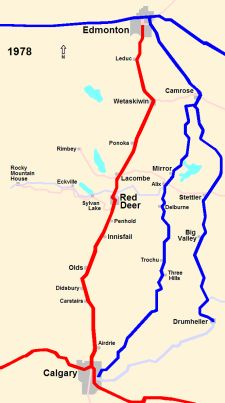
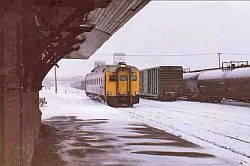 The CP Dayliners reached a peak of three trains a day in each
direction in 1969 carrying almost 80,000 passengers that year. The
following year, the number of trains was reduced to one in each
direction per day resulting in only 31,400 passengers that year and
only 23,400 passengers in 1971. At the order of the federal Railway
Transport Committee, the
frequency was increased to two trains per day in 1972. The
CP Edmonton downtown station was closed to passengers in 1971 (and demolished
in 1978), with Strathcona (south Edmonton) becoming the northern
terminus of CPR corridor passenger rail service (with a shuttle to
downtown), further eroding the desire for travellers to use the
train.
Canadian Pacific corridor service was reviewed in 1976 and 1979 by
the Railway Transport Committee after
public hearings in response to continued CP requests to cancel
passenger operations. Meanwhile, the government-owned VIA Rail took
over all CP and CN passenger service in 1978. The CP Dayliners reached a peak of three trains a day in each
direction in 1969 carrying almost 80,000 passengers that year. The
following year, the number of trains was reduced to one in each
direction per day resulting in only 31,400 passengers that year and
only 23,400 passengers in 1971. At the order of the federal Railway
Transport Committee, the
frequency was increased to two trains per day in 1972. The
CP Edmonton downtown station was closed to passengers in 1971 (and demolished
in 1978), with Strathcona (south Edmonton) becoming the northern
terminus of CPR corridor passenger rail service (with a shuttle to
downtown), further eroding the desire for travellers to use the
train.
Canadian Pacific corridor service was reviewed in 1976 and 1979 by
the Railway Transport Committee after
public hearings in response to continued CP requests to cancel
passenger operations. Meanwhile, the government-owned VIA Rail took
over all CP and CN passenger service in 1978.
The federal Committee ordered improved service in 1981 citing
the corridor had the best potential for rail passenger service outside
of the Quebec City-Windsor corridor.
Ridership increased to 53,000 in 1982, the highest since 1969.
One-way fare was $27.
However, grade crossing collisions and railway errors caused the public to
question the safety of Dayliner service. And poor integration with other transport modes and
connectivity caused much frustration.
In the early 1980s, Via Rail tested a new style of passenger train
in the corridor called the LRC (Light-Rapid-Comfortable) that was proposed for the
Calgary-Edmonton run but ended up only being used in Eastern Canada.
The Canadian National 'Railiner' between Calgary and Drumheller was discontinued
in 1971 but ran between Drumheller and Edmonton until 1981. The CN
Calgary-Edmonton 'Railiner' through Three Hills and Mirror was
cancelled in the 1970s.

The Dayliners continued on the CP Calgary-Edmonton corridor until
September 6, 1985
when the service was cancelled due to financial losses and at-grade
collisions after 94 years of continuous rail passenger service.
By the time the service ended, stops along the line were only at
Didsbury, Olds, Innisfail, Red Deer and Wetaskiwin.
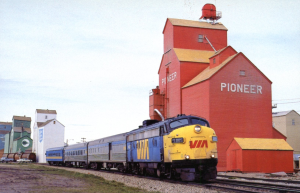
The
Red Deer CPR railyards were relocated from downtown to the west side of city
in
1991. The downtown station was closed but has been preserved.
Periodically, special excursion
trains, sometimes using vintage steam locomotives and passenger
cars, run through the corridor as well as the transcontinentals if
the main lines through the mountains are blocked.
A
private short line, the Central Western Railway, purchased the CN Stettler subdivision in 1986
and started steam train excursions along the line. A portion of the
line was sold to Alberta Prairie Railway
Excursions between Stettler and Big Valley, often, but not always,
using a steam locomotive.

 In
the 1980s, the concept of a high-speed rail line between Alberta's
two largest cities with a stop in Red Deer was proposed. The idea
keeps getting resurrected and shelved but there is currently growing
momentum to secure the right-of-way for such a service. As recently proposed, the high speed train would take 84
minutes from Calgary city centre to Edmonton city centre, run hourly
during the day and cost around $65 one way. The Red Deer terminal
has not been determined but would likely be west of the city
somewhere between the Red Deer Regional Airport and Highway 11.
Another proposal features a hyperloop technology transporting
passengers through high-speed tubes. In
the 1980s, the concept of a high-speed rail line between Alberta's
two largest cities with a stop in Red Deer was proposed. The idea
keeps getting resurrected and shelved but there is currently growing
momentum to secure the right-of-way for such a service. As recently proposed, the high speed train would take 84
minutes from Calgary city centre to Edmonton city centre, run hourly
during the day and cost around $65 one way. The Red Deer terminal
has not been determined but would likely be west of the city
somewhere between the Red Deer Regional Airport and Highway 11.
Another proposal features a hyperloop technology transporting
passengers through high-speed tubes.
The
Van Horne Institute released a study in 2004 suggesting that high speed
rail was viable in the Calgary-Edmonton corridor. The
Alberta government commissioned a study on high speed rail in 2006
which was completed in February 2008 and released to the public in July 2009.
The
Province also purchased property for possible future high speed terminals
in Calgary and Edmonton in 2007. Recently the Province undertook
another study on future transportation needs that could include
high-speed passenger rail.
Photo descriptions and credits:
Header:
Last steam locomotive at Canadian National Railway Red Deer station
1955 (Red Deer Archives P7009);
Immigrant train near Calgary 1883 (Glenbow Archives NA-664-3);
Early train on the Calgary and Edmonton Railway near Red Deer ca
1901 (Red Deer Archives);
Calgary & Edmonton Railway train at Innisfail 1890s (Glenbow
Archives NA-1709-71; Red Deer Archives);
Map of passenger service along Calgary-Edmonton corridor 1914 (Paul
Pettypiece);
CPR train at Bowden ca 1910 (Peel Postcards);
Nordegg/Brazeau 1914 Canadian Northern
mixed train ca 1925
(Glenbow Archives NA-5606-12);
CNorR mixed train at Saunders Creek mine east of Nordegg/Brazeau ca 1914 (Glenbow
Archives NA-1363-11);
First GTP passenger train at Mirror 1912 (source unknown via David
Muma);
Lacombe & Blindman Valley Electric Railway Baguley self-propelled car 1917 (Red Deer Archives P12785);
Last passenger train at Canadian National Railway Red Deer station
1955 (Red Deer Archives P7009);
CPR 'The Chinook' at Lacombe 1936 (Lacombe & District Historical
Society);
Map of passenger service along Calgary-Edmonton corridor 1954 map
(Paul Pettypiece);
CPR Dayliner passes Innisfail elevator row late 1960s (Canadian
Pacific Archives);
VIA Dayliner at Red Deer early 1980s (Brian McLoughlin);
Map of passenger service along Calgary-Edmonton corridor 1978 map
(Paul Pettypiece);
CPR 'The Canadian' detouring through Wetaskiwin 1972 (Wetaskiwin
Archives);
VIA train 195 replacing Dayliner with FP9 1405 May 1985 at Innisfail
(Peter Jobe, JBC Visuals);
Alberta Prairie excursion Stettler-Big Valley led by engine 41 (Paul
Pettypiece 2008);
Prairie Link Calgary-Red Deer-Edmonton high speed rail proposal
(Prairie Link)
|

